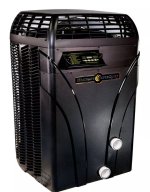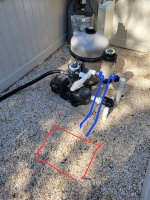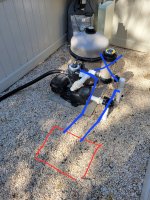Need some advice on plumbing in a new heat pump. This is the first heater for this pool so the existing filter/pump plumbing is pretty basic (Although I think there are too many 90 bends in a short space). The heater is a Aqucal 225 with the inlet being a bit higher then the outlet and both are off center on the heater. I was thinking the path of least resistance with minimal bends but I don't know if its really necessary. The only plumbing requirements that the manufacturer stated was to have at least 6 inches of straight pipe at the inlet and outlet. My pool plumbing is 1.5" so Ill have reducer right at the inlet and outlet.
I had 2 ideas (but maybe a more knowledgeable person has a better one). I don't use the chlorinator anymore since installing the stenner but I still leave it plumbed in. I figured removing it permanantly gives me the space needed to install the heater.
#1
- Keep the quick connect union in place that the chlorinator uses
- Add a quick connect on the other side where inlet of the chlorinator was into a 90
- Downward angled pipe into maybe a 45 followed by 6 inches of straight pipe into the heater inlet
- The outlet would follow the same idea and return into the opposite side of the chlorinator exit with another quick connect union
#2
- Exit the multiport valve appx 10-12 inches into a 90
- Downward angled pipe into maybe a 45 followed by 6 inches of straight tube into the inlet of the heater.
- The outlet would follow the same idea with a 45 angled upward and a 90 into the return. I would move the stenner inlet lower the the heater return is above the stenner.
Open to ideas from the pro's
I had 2 ideas (but maybe a more knowledgeable person has a better one). I don't use the chlorinator anymore since installing the stenner but I still leave it plumbed in. I figured removing it permanantly gives me the space needed to install the heater.
#1
- Keep the quick connect union in place that the chlorinator uses
- Add a quick connect on the other side where inlet of the chlorinator was into a 90
- Downward angled pipe into maybe a 45 followed by 6 inches of straight pipe into the heater inlet
- The outlet would follow the same idea and return into the opposite side of the chlorinator exit with another quick connect union
#2
- Exit the multiport valve appx 10-12 inches into a 90
- Downward angled pipe into maybe a 45 followed by 6 inches of straight tube into the inlet of the heater.
- The outlet would follow the same idea with a 45 angled upward and a 90 into the return. I would move the stenner inlet lower the the heater return is above the stenner.
Open to ideas from the pro's




